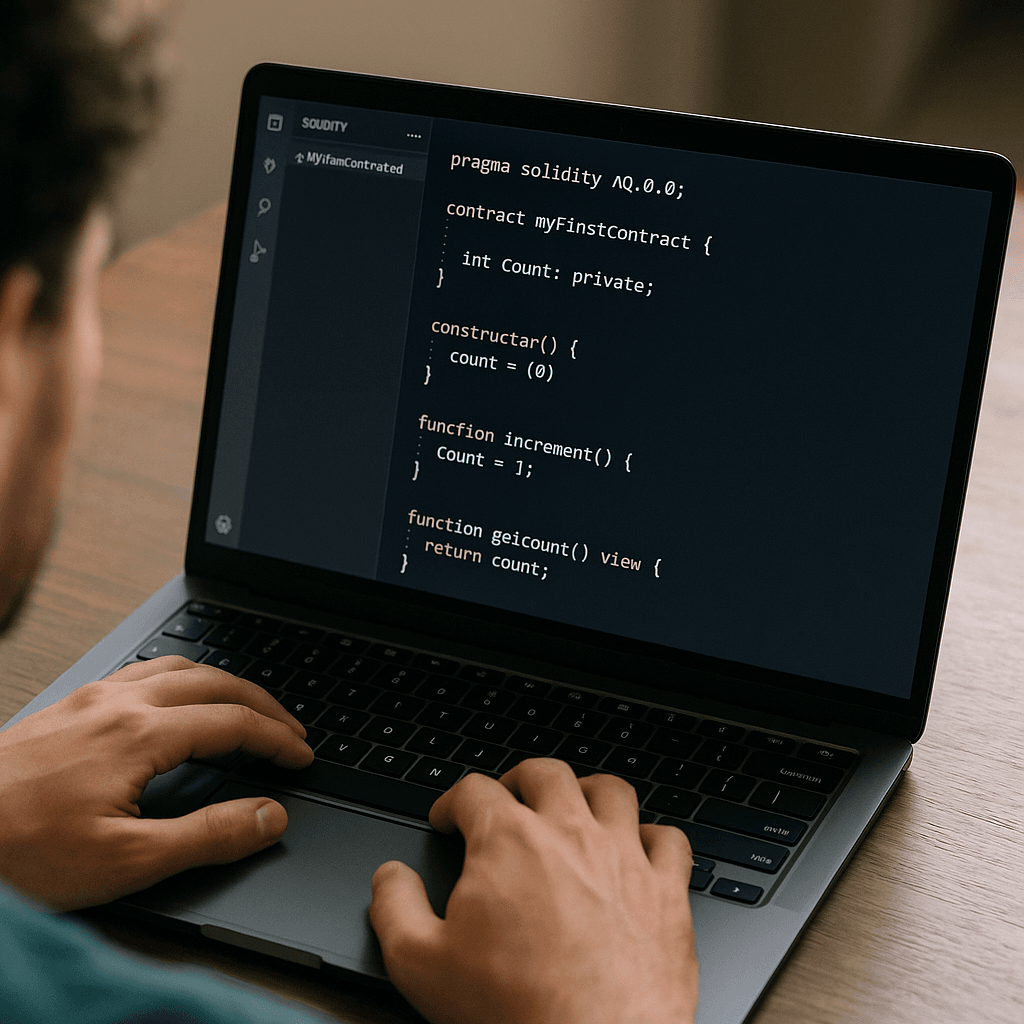Smart contracts have revolutionized blockchain development, enabling developers to create decentralized applications that execute automatically without intermediaries. Solidity, Ethereum’s primary programming language, serves as the gateway for developers entering the world of blockchain programming. Whether you’re a seasoned developer transitioning to Web3 or a complete beginner exploring decentralized technology, mastering Solidity fundamentals is essential for building successful smart contracts.
This comprehensive guide will walk you through creating your first smart contract using Solidity, covering essential concepts, syntax, and best practices that every blockchain developer should know. By the end of this tutorial, you’ll have written, deployed, and understood a functional smart contract that demonstrates core Solidity principles.
Understanding Smart Contracts and Solidity Basics
Smart contracts are self-executing programs stored on blockchain networks that automatically enforce predetermined rules and conditions. Unlike traditional contracts requiring human intervention, smart contracts execute autonomously when specific criteria are met, making them ideal for creating trustless, transparent applications.
Solidity is a high-level, object-oriented programming language specifically designed for writing smart contracts on Ethereum Virtual Machine (EVM) compatible blockchains. Its syntax resembles JavaScript and C++, making it accessible to developers familiar with these languages. Solidity compiles to bytecode that runs on the Ethereum Virtual Machine, ensuring contracts execute consistently across the network.
Before writing your first smart contract, you’ll need a development environment. Remix IDE, Ethereum’s browser-based development environment, provides an excellent starting point for beginners. It offers built-in compilation, deployment, and testing tools without requiring local installation. Alternatively, experienced developers might prefer local environments using Hardhat or Truffle frameworks.
Every Solidity smart contract begins with a pragma statement specifying the compiler version. This ensures your contract compiles correctly and maintains compatibility. Following the pragma declaration, contracts define state variables, functions, and modifiers that control contract behavior.
State variables store data permanently on the blockchain, while functions enable interaction with contract data. Solidity supports various data types including integers, booleans, strings, and arrays. Understanding these fundamental components is crucial for writing effective smart contracts.
Writing Your First Smart Contract: Step-by-Step Implementation
Let’s create a simple smart contract called “SimpleStorage” that demonstrates essential Solidity concepts. This contract will store and retrieve a number, showcasing basic state management and function implementation.
// SPDX-License-Identifier: MIT
pragma solidity ^0.8.0;
contract SimpleStorage {
uint256 private storedNumber;
event NumberStored(uint256 indexed newNumber, address indexed user);
modifier onlyPositive(uint256 _number) {
require(_number > 0, "Number must be positive");
_;
}
function storeNumber(uint256 _number) public onlyPositive(_number) {
storedNumber = _number;
emit NumberStored(_number, msg.sender);
}
function getStoredNumber() public view returns (uint256) {
return storedNumber;
}
function incrementNumber() public {
storedNumber += 1;
emit NumberStored(storedNumber, msg.sender);
}
}
This contract demonstrates several key Solidity concepts. The SPDX license identifier ensures proper licensing, while the pragma statement specifies compiler compatibility. The contract declares a private state variable storedNumber that persists data on the blockchain.
The storeNumber function allows users to store positive numbers, utilizing a custom modifier onlyPositive for input validation. Modifiers provide reusable code that executes before function logic, enhancing security and reducing redundancy. The require statement ensures only valid inputs are processed, reverting transactions that fail validation.
Events like NumberStored enable off-chain applications to monitor contract activity. They’re crucial for building user interfaces that respond to blockchain state changes. The indexed keyword makes event parameters searchable, improving query performance.
Function visibility modifiers control access levels. public functions are accessible externally and internally, while view functions promise not to modify state, enabling gas-free calls when executed locally.
The incrementNumber function demonstrates state modification without external input, showcasing internal contract logic. This pattern is common in gaming contracts, token systems, and automated protocols.
Testing and Deploying Your Smart Contract
Testing smart contracts thoroughly before deployment is critical, as blockchain transactions are irreversible. Remix IDE provides built-in testing capabilities, allowing you to interact with contracts in a simulated environment.
Deploy your contract to a test network like Goerli or Sepolia before mainnet deployment. Test networks use worthless test tokens, enabling risk-free experimentation. Acquire test Ether from faucets to pay for transaction gas fees.
When deploying, specify constructor parameters if your contract requires initialization. Gas estimation helps determine deployment costs, though actual costs may vary based on network congestion.
After deployment, interact with your contract through Remix’s interface or build custom front-end applications using Web3.js or Ethers.js libraries. These tools enable seamless integration between smart contracts and user interfaces.
Monitor deployed contracts using blockchain explorers like Etherscan. These platforms provide transaction history, contract verification, and interaction capabilities, essential for debugging and maintenance.
Consider implementing upgradeability patterns for complex contracts, though simple contracts like our example typically remain immutable. Upgradeability introduces complexity but enables bug fixes and feature additions.
Security Best Practices and Common Pitfalls
Security remains paramount in smart contract development. Common vulnerabilities include reentrancy attacks, integer overflow, and improper access control. Use established patterns and thoroughly audit code before deployment.
The Checks-Effects-Interactions pattern prevents reentrancy by performing validation first, updating state second, and interacting with external contracts last. This ordering prevents malicious contracts from exploiting state inconsistencies.
Input validation using require statements prevents invalid data from corrupting contract state. Always validate external inputs and consider edge cases that might cause unexpected behavior.
Gas optimization reduces transaction costs and improves user experience. Minimize storage operations, use appropriate data types, and avoid unnecessary computations. Tools like Hardhat Gas Reporter help identify optimization opportunities.
Regular security audits by experienced professionals identify vulnerabilities that automated tools might miss. Many high-profile exploits could have been prevented through proper auditing processes.
Conclusion
Writing your first Solidity smart contract marks an important milestone in blockchain development. This SimpleStorage example demonstrates fundamental concepts including state variables, functions, modifiers, and events that form the foundation of more complex applications.
Smart contract development requires careful attention to security, testing, and optimization. Start with simple contracts like our example, gradually increasing complexity as your understanding deepens. The blockchain ecosystem offers vast opportunities for developers willing to master these fundamental skills.
Continue exploring Solidity documentation, participate in developer communities, and practice building increasingly sophisticated contracts. The decentralized future depends on skilled developers who understand both the technical and practical aspects of smart contract development.
Remember that smart contract development is an iterative learning process. Each contract you write teaches valuable lessons about blockchain architecture, user experience, and decentralized system design. Your journey into Solidity programming opens doors to innovative applications that could reshape entire industries.




